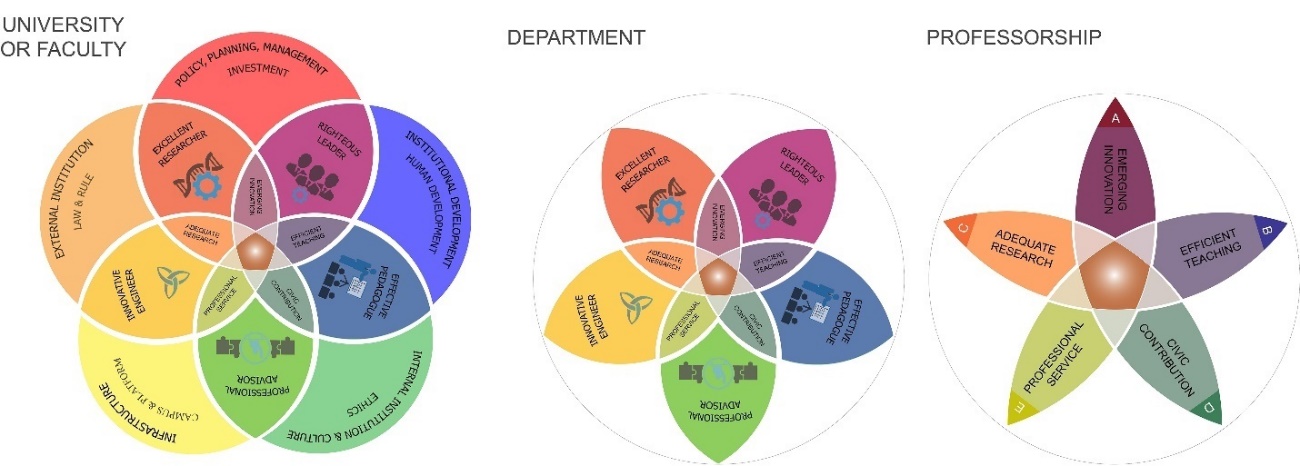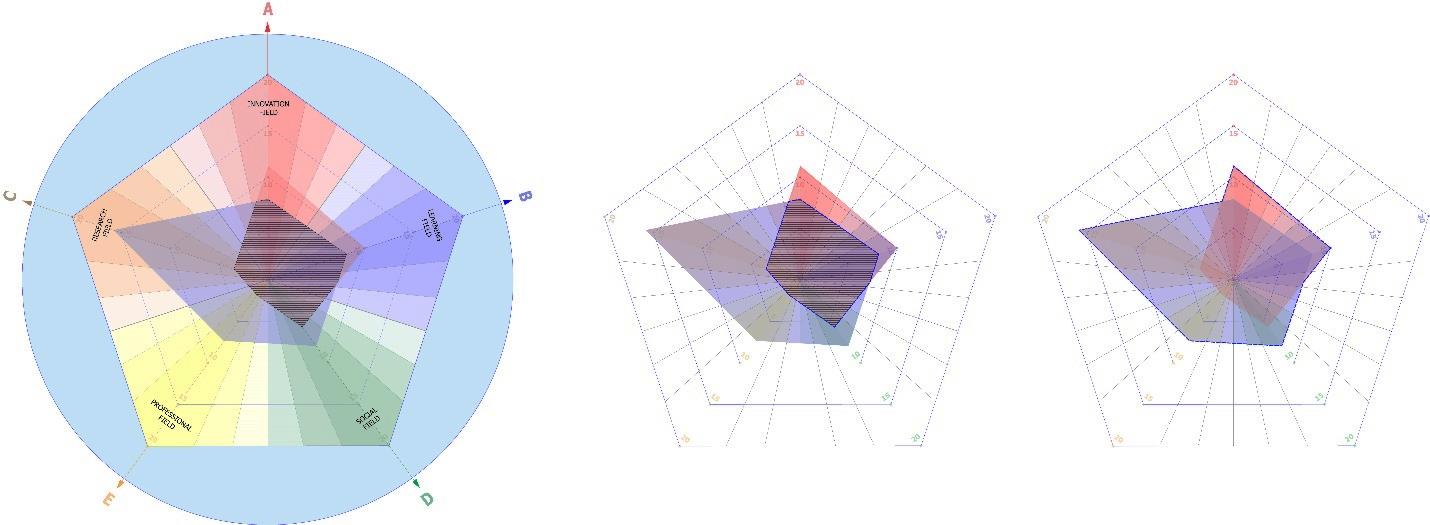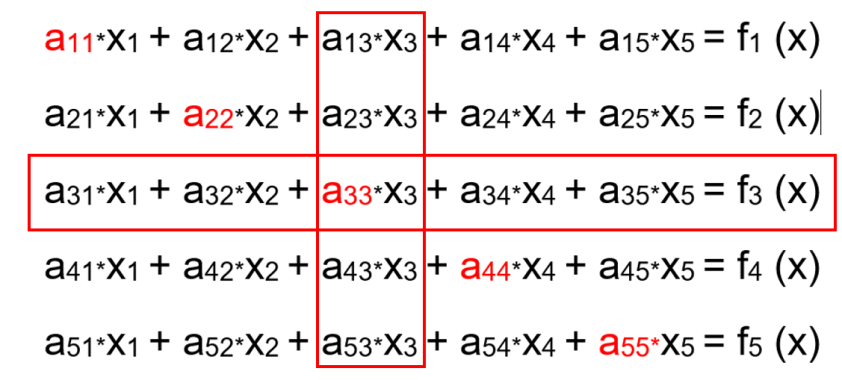Abstract
Mongolian universities are at the edge of huge paradigm shiftthat leads significant changes in academic work. Therefore, new conceptual model accounting complex and changingnature of academic work is need to be developed. The current study is purposed to develop concept model for evaluation, enhancement, promotion of university teachers, and for accelerating the leadership. The concept model was developed based on the idea derived from “Think Thank” group of Mongolian University of Science and Technology. A number of studies and international sources related teacher development framework, teacher’s standard and teacher leadership were investigated over past 5 years. Developed concept model starts with definiting university-department-professorship relationship and further extended identifying university professor’s five core roles. Professor’s workload capacity was expressed by function with 5x5 matrices defined by professor’s responsible activities as well as their coefficient of activity types, which can be used as key performance index.The model offers opportunities to develop quantitative assessment tool for professor’s performance, to enhance human resource management system, and to update existing compensation or leadership promotionsystem. The developed concept model can be used as a benchmark for further development of professional development framework, university teacher standard, as well as national system of HE capacity building.
Keywords: Concept model, higher education, leadership, teacher development, workload
Introduction
The concept of effective leadership has become increasingly embedded to the educational improvement. It is evident from international studies that the effective leadership provide powerful indirect influence on school improvement and on the student learning achievement (Daniëls et al., 2019). Specifically, the teacher leadership suggests that teachers hold a central position in the ways schools operate and in the core functions of teaching and learning (Wenner & Campbell, 2017). Moreover, leadership has been identified as leverage for transformation, organization culture forming, and community building (Lesinger et al., 2016). Literature survey relieves that education leadership is necessary if change is to take hold (Sagnak, 2016). Therefore, leadership should be considered as a key for successful educational improvement, especially in thisera of educational paradigm shift.
Mongolian higher education (HE) system and universities were originated from the HE system of old Soviet Union, in which the universities focused primarily on teaching. Whereas the Academy of Sciences and its specialized research institutions, which were not part of the HE system, conducted research. As a result, research functions and graduate programs at universities are underdeveloped (Sumberzul & Oyunbileg, 2018). Recently, Government of Mongolia started focusing onenhancing research capacity of Mongolian universities (Zoljargal, 2020). Ministry of Education launched a “National Program on Research Universities (2018–2022)”. Thus, Mongolian Universities are at the edge of huge shift that defined as a transformation of teaching university into research-oriented university.Moreover, triple helix model of university-industry-government interaction becoming a benchmark for innovation development process (Leydesdorff, 2018) Therefore, universities are also challenged to be entrepreneurial university.
Teaching to research or innovation transformation is not only challenge in Mongolian HE. Sustainable development goal (SDG) forced universities to increase their civic contribution and thus the civic engagement becoming another major challenge at universities (Zamora-Polo & Sánchez-Martín, 2019). Rapid changes of information technology already had signification impact on HE. Current pandemic situation of COVID-19 accelerated use of ICT in HE. Invasion of technology in education reshaped HE system and leading to the teaching to learning transformation (Ossiannilsson et al., 2016).
These unprecedented challenges and paradigm shift in HEsector forced us to rethink changing aspect of academic work. Coaldrake and Stedman (1999) well outlinedmain aspect of changes in academic work considering pressure on time, workload, ethical issues, performance, professional standard, accountability, specialization and complexity of university work, diffusion and blurring of academic staff role.
Problem Statement
An existing system of workload allocation, performance evaluation and promotion, as well as compensation in Mongolian HE sector generallyaccounting teaching role of university professor.Most of teachers complain about misjudgment of performance evaluation and compensation system, which is one factor for leadership development as a key motivational driver. Therefore, new conceptual model that accounts changing nature of teacher’s role is necessary.
Research Questions
- What will be future role of university teachers?
- Can we model complex academic work capacity using single form of algebraic equation?
- What can we do using such model if we succeed to develop generic model?
Purpose of the Study
The purpose of current study is to develop concept model describing of complex academic work of university teachers that can be utilized performance evaluation, leadership enhancement, human resource planning as well as merit compensation at universities.
Research Methods
An idea to develop concept model was derived from “Think Thank” group of Mongolian University of Science and Technology (MUST), the group of individuals who purposed to change an existing performance evaluation system of university teachers at MUST. A number of surveys and face-to-face discussions to identify drawback of existing performance evaluation system were conducted.
National policies and initiatives on HE (Government policy on science and technology, 2014-2025; Government policy on innovation, 2018-2025; National program on research university, 2018-2022; National human resource development program in science, technology, and innovation, 2019; SDG-2030 Mongolia; Vision-2050 Mongolia long term development plan, etc.) were reviewed to define future changes in HE and in teacher’s role.
To evaluate international trends in HE, paradigm shift or challenges facing at universities, and changes on academic work of university teachers the group were reviewed international studies (Koster & Dengerink, 2008; Lindberg-Sand & Sonesson, 2008), teacher development frameworks (Aitken & Tatebe, 2014) and international standards for teachers including (Lifelong learning, U. K., 2009; Henderson & Jarvis, 2016).
Finally, we tried to demonstrate university-department-professorship relationship, future role of university teacher, teacher’s workload capacity. The workload capacity model was expressed using general equation of matrix.
Findings
Developed concept model defining relationship between university-department-professorship was shown in Figure 01. At macro level, university can be viewed as a system consisted of 1) governance & management-investment, 2) institutional development-human resource planning, 3) internal institutional aspect- culture or ethics, 4) external institutional aspect-law legislation and 5) infrastructure- campus or platform.
At meso level, the departments are core engine of university where 1) excellent researchers, 2) righteous leaders, 3) teaching individual with effective pedagogue, 4) professional advisor, and innovative engineers should be accumulated.
At micro level, the final unit of university should be professorship, in which professors need to do five main activities including emerging innovation, adequate research, efficient teaching& learning, professional service, and civic contribution or engagement.

To define workload capacity of university teacher, let’s express teachers or professor’s five roles as x1-teaching& learning, x2-research, x3-innovate, x4-professional service, and x5-civic contribution or engagement. In simple form, the teacher’s workloadcapacity can be expressed as
a1*x1+ a2*x2+ a3*x3+ a4*x4+ a5*x5=f (x) eq.1
where, suppose ai is a coefficient of power indicatingthe importance of related activities. However, problem arise from that all xi teacher’s activities are inter-related. For instance, which category will be if teacher’s performance related pedagogic innovation, is it registered in teaching-x1 or innovation-x3? Or, what is main activity category if the teacher performs research that facilitate civic engagement, is that research-x2 or civic contribution-x5? Same problems are derived from all xi. The main drawback of current performance evaluation system, where all teachers complain about misjudgment, is originated fromthe system does not consider above mentioned inter-relation.
To create more flexible performance evaluation system, accounting complex nature of teacher’s role, that can further accelerate teacher leadership, we extended the simple form of workload capacity equation in multi-dimensional matrix form as follows
a11*x1 + a12*x2 + a13*x3 + a14*x4 + a15*x5 = f1 (x)
a21*x1 + a22*x2 + a23*x3 + a24*x4 + a25*x5 = f2 (x)
a31*x1 + a32*x2 + a33*x3 + a34*x4 + a35*x5 = f3 (x)
a41*x1 + a42*x2 + a43*x3 + a44*x4 + a45*x5 = f4 (x)
a51*x1 + a52*x2 + a53*x3 + a54*x4 + a55*x5 = f5 (x)eq.2
In equation 2, a11, a22, a33, a44, and a55 diagonal coefficients can represent directly related activities of teaching, research, innovation, professional service, and civic contribution, respectively. While, other aij coefficients can represent distinguished inter-related activities. For example, a12 indicates activities related teaching-oriented research (such as: educational research, pedagogic studies etc…). In other hand, a21 indicates activities related research-oriented teaching (such as project based teaching in graduate program). a13 indicates teacher’s activities related teaching-oriented innovation (such as: implementing ICT in teaching program or introducing new innovative teaching pedagogy). While, a31 indicates innovation-oriented training (such as: training to adapt new technology in teaching practice). So forth, all distinct characteristic of aij can be defined.
All xi, the list of HE theacher’s work activities, can be determined from current database. Let’s assume that we can divide those list of work into respective aijcategories. In such case, the purposed workload capacity equation is solvable and can be used as a quantitative tool for performance evaluation as well as merit compensation. However, determining optimum value of coefficient aij that is suitable for every HE institution is impossible. Universities can decide powerof aijcoefficients (ranged from 1 to 10) based on their primary strategic direction and internal as well as external legislation. For example, in case of MUST which strategically planned to increase their research capacity, coefficient ai2or a2j can be chosen as higher as possible. Controlling these power coefficients in workload capacity model may allow HE institutions to control their achievement of strategic plan.
The workload capacity model, the numerical equation, can only be quantitative tool to evaluate HE teacher’s performance. Thus, we assume there is a need of visually designed tool to promote faculty development, to increase leadership, to facilitate teamwork, and to compare departments or schools for increased competition as well as cooperation. Therefore, the concept of penta persona (PP) data analyzation and visualizationtoolwas implemented in this study (Figure 02). PP has five axes including A (innovation), B (teaching & learning), C (research), D (social service or contribution), and E (professional service), respectively.

In Figure 2, an example of performance comparison between two distinct professors was provided. Suppose that the numerical value at each five axes were quantified from workload capacity model. For instance, numerical value of Aaxis, which is innovation,can be calculated using equation 3.
A=∑ f (ai3, a3j) eq. 3
Where, all element of column 3 and row 3 in matrix should be considered (Figure 03).

To our understanding, PP data analyzation and visualization tool provide several advantages.
- First, for micro level (Figure01), individual professor can see where they are for each 5 axes in comparison with colleagues. This will stimulate self-motivation and leadership enhancement of faculty members. It may be providing opportunity to decide who should he or she team up to increase their capacity.
- Second, for meso level (Figure01), departments can identify their current competence using intersection shape area or can see their future development potential using united share area (Figure 02). Showing department to department or school to school comparison via PP visualization tool will eventually lead competition, which is important factor for educational improvement.
- Third, for Macro level, purposed PP data analyzation and visualization tool can be used as human resource management tool for capacity building, performance monitoring, leadership enhancement,to assess departments by making analyzes faculty members.
Conclusion
Conceptual model that can be used for developing teacher’s performance evaluation & promotion, leadership enhancement, and merit compensation system at universities was developed by definingteacher’s workload capacity equation in multi-dimensional matrix form. The concept of penta persona data analyzing and visualization tool was also introduced to promote faculty development, to increase leadership, to facilitate teamwork, and to increased competition between departments. Developed model can be used as a benchmark for further development of professional development framework, university teacher standard, as well as national system ofHE capacity building.
Acknowledgments
This work was supported by DeSTT - Development of Skills and Teachers Training for Leadership Project with Reference Number: 609905-EPP-1-2019-1-IT-EPPKA2-CBHE-JP
References
Aitken, G., & Tatebe, J. (2014). Recognition of Teaching Excellence: a discussion paper. Retrieved from http://www.universitas21.com/article/educational/details/273/recognition-of-teaching-excellence
Coaldrake, P., & Stedman, L. (1999). Academic work in the twenty-first century: changing roles and policies (Occasional Paper Series 99H). Department of Education, Training and Youth Affairs (Higher Education Division).
Daniëls, E., Hondeghem, A., & Dochy, F. (2019). A review on leadership and leadership development in educational settings. Educational research review, 27, 110-125.
Henderson, L., & Jarvis, J. (2016). The gifted dimension of the Australian professional standards for teachers: Implications for professional learning. Australian Journal of Teacher Education, 41(8), 60-83.
Koster, B., & Dengerink, J. J. (2008). Professional standards for teacher educators: how to deal with complexity, ownership and function. Experiences from the Netherlands. European Journal of Teacher Education, 31(2), 135-149.
Lesinger, F., Dagli, G., Gazi, Z. A., Yusoff, S. B., & Aksal, F. A. (2016). Investigating the relationship between organizational culture, educational leadership and trust in schools. International Journal of Educational Sciences, 15(1-2), 178-185.
Leydesdorff, L. (2018). Synergy in knowledge-based innovation systems at national and regional levels: The Triple-Helix model and the Fourth industrial revolution. Journal of Open Innovation: Technology, Market, and Complexity, 4(2), 16.
Lifelong Learning, U. K. (2009). Northern Ireland professional standards for teachers, tutors and trainers in the lifelong learning sector. http://dera.ioe.ac.uk/190/1/Professional_Standards_for_TTTS_in_NI_-_FINAL_April2009.pdf
Lindberg-Sand, Å., & Sonesson, A. (2008). Compulsory higher education teacher training in Sweden: Development of a national standards framework based on the Scholarship of Teaching and Learning. Tertiary Education and Management, 14(2), 123-139.
Ossiannilsson, E., Altinay, Z., & Altinay, F. (2016). Transformation of teaching and learning in higher education towards open learning arenas: A question of quality. In P. Blessinger & T. Bliss (Eds.), Open education: International perspectives in higher education (pp. 159-177). Open Book Publishers.
Sagnak, M. (2016). Participative Leadership and Change-Oriented Organizational Citizenship: The Mediating Effect of Intrinsic Motivation. Eurasian Journal of Educational Research, 62, 181-194.
Sumberzul, N., & Oyunbileg, S. (2018). Higher education research in Mongolia during the transition period of development. In Researching Higher Education in Asia (pp. 213-221). Springer.
Wenner, J. A., & Campbell, T. (2017). The theoretical and empirical basis of teacher leadership: A review of the literature. Review of educational research, 87(1), 134-171.
Zamora-Polo, F., & Sánchez-Martín, J. (2019). Teaching for a better world. Sustainability and sustainable development goals in the construction of a change-maker university. Sustainability, 11(15), 4224.
Zoljargal, D. (2020). A case study of higher education in Mongolia: Institutional Isomorphism. InternationalJournal of Higher Education, 9(1), 107-115.
Copyright information

This work is licensed under a Creative Commons Attribution-NonCommercial-NoDerivatives 4.0 International License.
About this article
Publication Date
15 July 2021
Article Doi
eBook ISBN
978-1-80296-113-3
Publisher
European Publisher
Volume
114
Print ISBN (optional)
-
Edition Number
1st Edition
Pages
1-778
Subjects
Globalization, digital education, leadership, challenges of the time, оn-line pedagogy, universal and national values
Cite this article as:
Radnaa, N., Davaa, A., Dashzeveg, T., & Purevsuren, T. (2021). Development Of Concept Model For Evaluation, Enhancement And Promotion Of University Teachers. In A. G. Shirin, M. V. Zvyaglova, O. A. Fikhtner, E. Y. Ignateva, & N. A. Shaydorova (Eds.), Education in a Changing World: Global Challenges and National Priorities, vol 114. European Proceedings of Social and Behavioural Sciences (pp. 43-50). European Publisher. https://doi.org/10.15405/epsbs.2021.07.02.6

